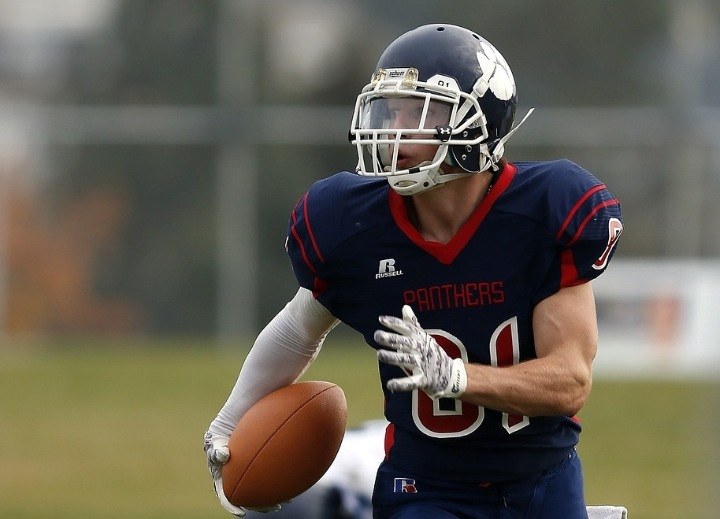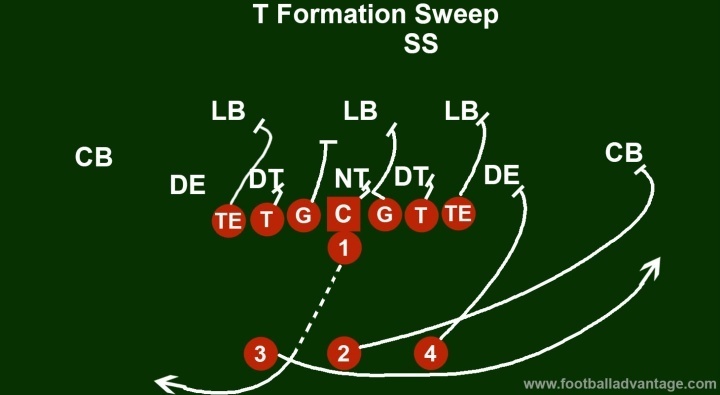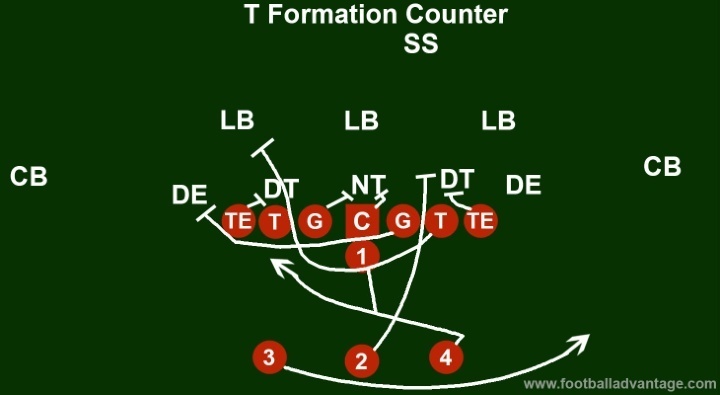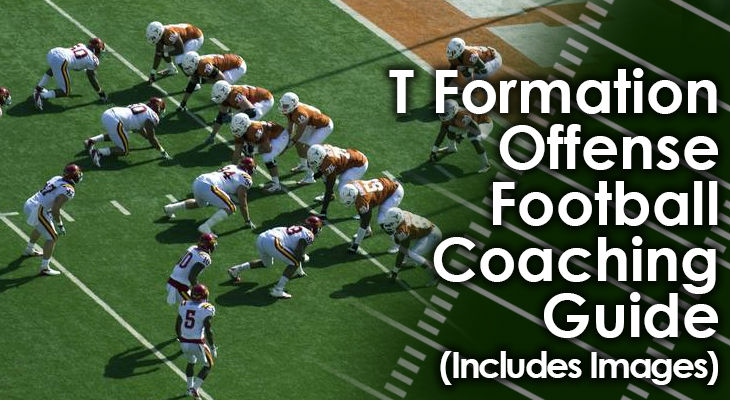The T Formation is one of the most popular offenses for youth football teams to run.
Because these youth football teams like to run the football more than they pass the football due to the lack of strength a quarterback usually has to throw the football…
The T Formation is a great way to have an offense that teaches these young players how to play the game, while keeping the defense off balance in the meantime.
The T Formation is named for the shape that the alignment of players in the backfield creates – with the center and the quarterback forming the straight vertical line of the T, and the three running backs in the backfield forming the straight horizontal line at the top of the letter.
The best part about the T Formation is that, even though it may be obvious to the defense that each play is going to be a run (or at least most plays will), it’s hard to determine who is going to get the ball on any given play.
In addition, because the formation is considered balanced (with the same players on each side of the field), the defense can’t key in or load up on defending one side of the field or the other.
Who Should Use the T Formation Offense?
Teams Who Have Less Experienced Players - The T Formation is used most prominently at the youth levels of football because of their propensity to run the football over passing. The T Formation gives these teams a great option for having a run-heavy offense while still being unpredictable.
Teams Who Have Good Running Backs - The T Formation will have three players in the backfield on every play. So not only is important that teams that run the offense have good players who can carry the football, it’s also important that these backs are able to serve as lead blockers, too.
Teams On Which the Quarterback Can Run - Teams at higher levels of football can run the T formation as well, if their quarterback doesn’t have a great arm, or if he has the ability to run. This extra runner would add another level of possibilities to the offense.
Who Should Not Use the T Formation Offense?
Teams Who Like to Throw the Ball - Teams with a good quarterback, good wide receivers and generally a set of skills to pass the football won’t do well with a T Formation. The offense is designed as a run-heavy formation.
Teams Who Can’t Pound the Ball on the Ground - Even if your team would rather run the football, the T Formation won’t be a good fit if you don’t like to run in more of a “ground and pound” style. This offense is designed for the power running game, not for a more finesse style such as that in a Spread Option, for example.
Teams Who Are Smaller - The T Formation requires its players to be on the bigger side, especially along the offensive line, as they will be forced to endure a more physical game, with all the run blocking. As such, teams that don’t have this size, or that can’t handle all that blocking, wouldn’t be a good fit for the T Formation.

T Formation Offense Personnel
The T Formation gets its name from what the formation looks like.
Because of this, the T Formation will use the same personnel on every single play.
There will be no wide receivers on the field in this offense.
Here is the more traditional personnel in a T Formation offense:
Backfield:
- Quarterback (1)
- Fullback (2)
- Left Halfback (3)
- Right Halfback (4)
Offensive Line
- Center (C)
- Two Guards (G)
- Two Offensive Tackles (T)
- Two Tight Ends (TE)
T Formation Offense Formation
On most plays, the T Formation will line up in the same format that gives the offense its name.
How the players align will end up looking like the letter T.
Some changes can be made to the basic formation, though, that could add an extra wrinkle or make the defense make even more adjustments.
The standard formation for all T Formation plays are:
Center - Will line up on his normal position over the football.
Guards - Will line up at their normal positions, on either side of the center.
Offensive Tackles - Will line up at their normal positions, on either side of the guards.
Tight Ends - Will both line up at the line of scrimmage, on either side of the offensive tackles.
Quarterback - Will line up directly under center.
Fullback - Will line up directly behind the quarterback, about five yards deep.
Left Halfback - Will line up directly behind the offensive tackle on the left side of the field, at the same five-yard depth in the backfield.
Right Halfback - Will line up directly behind the offensive tackle on the right side of the field, at the same five-yard depth in the backfield.
2 T Formation Offense Plays
The best way to see how the T Formation works is to break down two different running plays.
One that is more straightforward and designed to smash the ball up the field, and one that is more of a misdirection play and designed to create some confusion with the defense.
T Formation Sweep

The T Formation Sweep is a play designed to run the ball from the left side of the backfield to the outside of the offensive formation.
The design of the play will hand the ball off to the Left Halfback, and give him two lead blockers in the backfield with both the Fullback and the Right Halfback, which will give the offense more blockers on the right side of the field than the defense will have possible tacklers.
Here is the breakdown of the personnel and the responsibility of each player:
Center - He will line up over the ball in his normal position. At the snap of the ball, the center will block the nose tackle lined up across from him, shielding him off from the right side of the field.
Guards - Both guards will line up next to the center. At the snap, the left guard will immediately get downfield and try to block the middle linebacker (Mike). The right guard will chip on the nose tackle, helping the center in his blocking duties, and then quickly get downfield to shield the Mike linebacker from the right side of the field. He will also keep an eye out for the strong safety, who could be creeping toward the ball carrier.
Offensive Tackles - Both offensive tackles will line up next to the guards. At the snap, they will each be responsible for blocking the defensive tackles lined up directly opposite them, again shielding them from the right side of the field. This will be especially important for the right offensive tackle, since the play will be going his way.
Tight Ends - Both tight ends will line up next to the offensive tackles. The left tight end will provide a quick chip block on the defensive tackle and then get to the second level as fast as possible to shield off the linebacker (Will) on that side of the field. The right tight end will not provide a chip block on the defensive tackle, because he will need to quickly get downfield to block the linebacker (Sam), who will be much closer to where the ball carrier will try to run.
Right Halfback - He will line up directly behind the offensive tackle on the right side of the field, about five yards in the backfield. At the snap, he will be responsible for blocking the right defensive end, who will be roaming free. It is essential that he get to that player as quick as possible, since the end will be the closest defender to the ball carrier on that side of the field.
Fullback - He will line up directly behind the quarterback, about five yards in the backfield. At the snap, he will be responsible for taking an outside route to the block the cornerback lined up on the outside right side of the field. This cornerback will again be roaming free, since no offensive player will be lined up across from him.
Quarterback - He will line up under center and take the snap directly from the center. Once he does, he will run back and open up to the right side, handing the ball off to the Left Halfback.
Left Halfback - He will line up directly behind the left offensive tackle, about five yards in the backfield. He will serve as the ball carrier on this play, taking the handoff from the quarterback and following his two lead blockers (the Fullback and Right Halfback) toward the outside right side of the field.
T Formation Counter

The idea of this play is to show the defense the same exact formation as the sweep play above, but then cause some confusion (and hopefully create some openings for a big play) but faking the run to the right and then running to the left.
The fake will occur by faking the handoff to the Fullback, having the Left Halfback fake a run to the outside, and then having the Right Halfback take the handoff and run to the left.
Here is the breakdown of the personnel and the responsibility of each player:
Center - He will line up in his normal position over the ball. Once he snaps the ball, he will be responsible for blocking the nose tackle lined up opposite him directly forward.
Left Guard - He will line up just to the center’s left. At the snap, he will block down on the nose tackle, double teaming this player with the center. His job is to seal off the nose tackle from the left side of the field.
Left Offensive Tackle - He will line up just to the left guard’s left. He will be responsible for blocking the defensive tackle lined up opposite him straight forward.
Left Tight End - He will line up just to the left offensive tackle’s left. At the snap, he will block down on the defensive tackle, double teaming that player with the offensive tackle. His job will be to shield the defensive tackle from the left side of the field.
Right Guard - He will line up just to the center’s right. At the snap, he will pull behind the center and left guard, taking a slightly diagonal route to block the left defensive end. It will be key for him to kick out the defensive end toward the left sideline, as the ball carrier will be running through the C gap that will be just to this guard’s right.
Right Offensive Tackle - He will line up just to the right guard’s right. At the snap, he too will pull to the left side of the field. He will take a more direct route, turning upfield between the left tight end and left offensive tackle. His responsibility will be to block the linebacker lined up on the left side of the field.
Right Tight End - He will line up just to the right of the right offensive tackle. At the snap, his job will be to block the defensive tackle lined up across from the offensive tackle, shielding him off from the left side of the field as best as possible.
Fullback - He will line up directly behind the quarterback, about five yards in the backfield. At the snap, he will take a direct route through the B gap, faking that he is getting the handoff for a run up the gut. Once he gets through the line of scrimmage, he will block the first defensive threat in his sights, which could be one of the linebackers at the second level.
Left Halfback - He will line up directly behind the left offensive tackle, about five yards in the backfield. At the snap, he will take a wide route to the right side of the field as if he were going to run a sweep to the outside. He will be strictly a decoy on this play.
Quarterback - He will line up under center. Once he takes the snap from the center, he will open up to the right side of the field. He will first fake the handoff to the Fullback, and instead hand the ball off to the Right Halfback.
Right Halfback - He will line up directly behind the right offensive tackle, about five yards in the backfield. At the snap, he will first take a quick diagonal step to his right, as if he were going to block toward the right side of the field. Then, he will cut quickly back to his left, taking the handoff from the quarterback. As the ball carrier on this play, he will take a route toward the C gap on the left side of the field, using the pulling guard and pulling offensive tackle as his lead blockers.
Conclusion
The T Formation is a great offense for a youth football team who is just learning the game and who may not have the ability to throw the football a lot.
One of the main reasons youth football coaches love the T Formation is because it’s very easy to implement and teach to their players.
In addition, it’s also a good way to keep defenses off their toes, as it’s hard for defenses to identify where the ball is going to be run on any single play.
These reasons are some of the same ones why the T Formation is not used much by teams at more advanced levels of football.
This offense doesn’t cater well to teams that like to have a good balance between the pass and the run, and/or that have a more traditional make-up of players that includes good wide receivers and not as many running backs.

